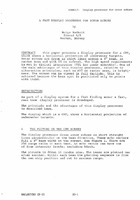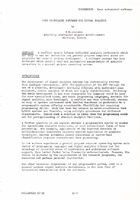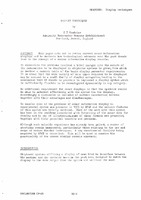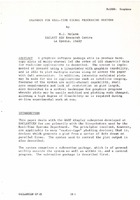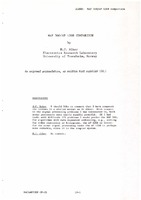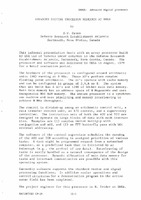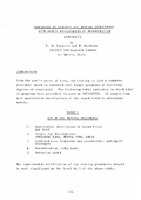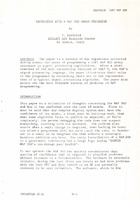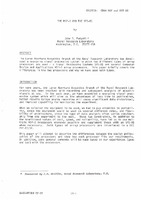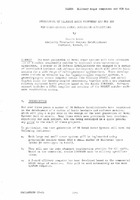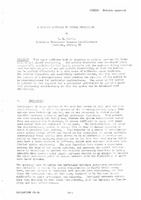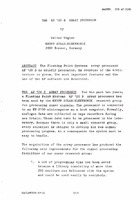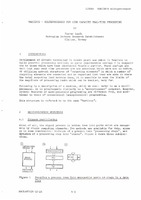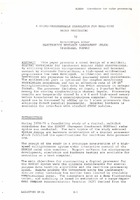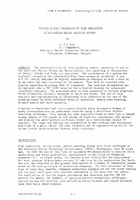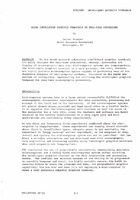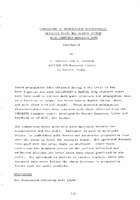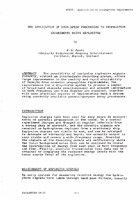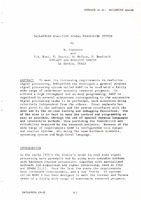Reprints: Recent submissions
Now showing items 501-520 of 548
-
A fast display processor for sonar echoes
(NATO. SACLANTCEN, 1979/12)This paper presents a display processor for a CRT, which shows a horizontal projection of underwater targets. Sonar echoes are drawn as short lines across a 50 beam, in random scan and with 50 Hz refresh. The high speed ... -
User-orientated software for signal analysis
(NATO. SACLANTCEN, 1979/12)A conflict exists between dedicated analysis instruments which are easy to use but inflexible and general purpose computers which are adaptable but require program development. A software package has been. developed which ... -
Display techniques
(NATO. SACLANTCEN, 1979/12)This paper sets out to review current sonar information displayc and to indicate how technological advances over the past decade lead to the concept of a common information display console. To appreciate the problems ... -
Graphics for real-time signal-processing systems
(NATO. SACLANTCEN, 1979/12)A graphics software package able to produce hardcopy plots of multi-channel (of the order of 100 channels) data for real-time applications is described. The system is implemented at present using a lineprinter with graphics ... -
Overview of the ADPS signal processor
(NATO. SACLANTCEN, 1979/12) -
MAP 300/AP 120B comparison
(NATO. SACLANTCEN, 1979/12) -
Advanced digital processor research at DREA
(NATO. SACLANTCEN, 1979/12)This informal presentation deals with an array processor built by ESE Ltd of Toronto under contract to the Defense Research Establishment Atlantic, Dartmouth, Nova Scotia, Canada. The processor and software was delivered ... -
Comparison of CONGRATS ray tracing predictions with MEDUSA measurements of reverberation
(NATO. SACLANTCEN, 1971/12)From the user's point of view, ray tracing is just a computer procedure which is inserted into larger programs of different degrees of complexity . The following table indicates in which kind of programs this procedure is ... -
Experience with a MAP 300 array processor
(NATO. SACLANTCEN, 1979/12)The paper is a summary of the experience collected during almost two years of programming a CSPI MAP 300 array ' processor in signal processing applications. After a short overview of the most interesting features of SNAP ... -
The MPS-3 and the SPS-81
(NATO. SACLANTCEN, 1979/12)The Larqe Aperture Acoustics Branch of the Naval Research Laboratory has developed a sea-qoinq signal processinq system in which two different types of array processors are used - a Signal Processing Systems SPS-81 and ... -
Development of military ARGUS computers and MOD bus for close-coupled signal processing applications
(NATO. SACLANTCEN, 1979/12)The next generation of Naval sonar systems will make extensive use of flexible programable modules to implement signal-processing algorithms. A number of UK Defence Establishments are engaged in a series of coordinated ... -
A modular approach to signal processing
(NATO. SACLANTCEN, 1979/12)This paper outlines work in progress on modular systems for beamforming and signal processing. The modules described were developed using commercially available digital L.S.I circuits and the emphasis during development ... -
The AP-120B array processor
(NATO. SACLANTCEN, 1979/12)The Floating Point Systems array processor AP 120 B is briefly presented. An overview of the architecture is given. The most important features and the use of the AP software are described -
Martinus - multiprocessor for high capacity real-time processing
(NATO. SACLANTCEN, 1979/12)Development of circuit technology in recent years now makes it feasible to build powerful processing machines at quite considerable savings - in comparison to those which have been considered feasible earlier. These savings ... -
A micro-programmable correlator for real-time radar processing
(NATO. SACLANTCEN, 1979/12)This paper presents a novel design of a multibit, digital correlator for incoherent scatter radar observations. By utilizing bit-slice microprocessor elements and internal control by microcode instructions, a high-speed ... -
Digital signal processing of high resolution within-pulse sector scanning sonars
(NATO. SACLANTCEN, 1979/12)The characteristics of three scanning sonars, presently in use at the Admiralty Marine Technology Establishment, and operating at frequencies of 300kHz, 150kHz and 75kHz are described. The performance of a system for ... -
Using intelligent graphics terminals in real-time processing
(NATO. SACLANTCEN, 1979/12)At the Naval Research Laboratory intelligent graphics terminals are being utilized for real-time acquisition, storage, processing and display of oceanographic data when mini-computer systems are inappropriate. The intelligent ... -
Comparison of propagation measurements obtained using the MEDUSA system with computer modelled data
(NATO. SACLANTCEN, 1971/12) -
The application of high-speed processors to propagation experiments using explosives
(NATO. SACLANTCEN, 1979/12)The possibility of analysing explosive signals directly, without an intermediate recording system, offers large improvement~ in the quality and rapid availability of results from acoustic propagation experiments. The ... -
SACLANTCEN real-time signal processing system
(NATO. SACLANTCEN, 1979/12)To meet its increasing requirements in real-time signal processing, SACLANTCEN has developed a general purpose. signal processing system called WARP to be uS.ed with a fairly wide range of underwater acoustic research ...
